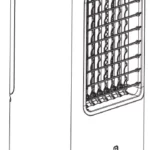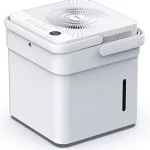

Top-Load Washer
USER MANUAL &
INSTALLATION
INSTRUCTIONS
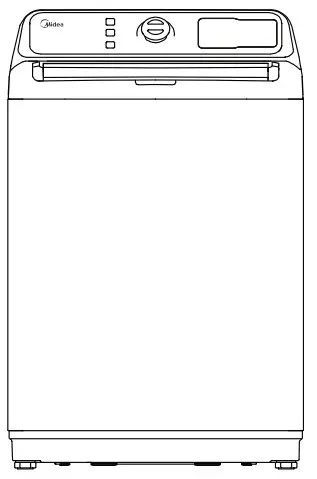
| Free 3 months extension* of the original limited warranty period! Simply text a picture of your proof of purchase to: 1-844-224-1614
*The warranty extension is for the three months immediately following the completion of the product’s original warranty period. |
MODEL NUMBERS
MLV45N1BWW
MLV45N3BWW
www.midea.com
Power supply: 120V
Frequency: 60Hz
Capacity: 4.5 cu ft
Warning:
Before using this product, please read this manual carefully The design and specifications are subject to change without prior notice for product improvement. Consult with your dealer or manufacturer for details.
version A
Dear user
THANK YOU and CONGRATULATIONS on your purchase of this high-quality Midea product. Your Midea washer is designed for reliable, trouble-free performance. Please take a moment to register your new washer. Register your new washer at www.midea.com under the Support tab.
For future reference, record your product model and serial numbers located on the inside frame of the washer.
Model Number____________________________________
Serial Number_____________________________________
READ AND KEEP THESE INSTRUCTIONS FOR FUTURE REFERENCE
This manual contains important information on the installation, use, and care of your appliance. Please read this manual carefully before installation and operation of this machine to prevent injury and property damage.
Warnings and Important Safety Instructions in this manual DO NOT cover all possible conditions and situations that may occur. It is your responsibility to use common sense, caution, and care when installing, maintaining, and operating your washer.

SAFETY INSTRUCTIONS
YOUR SAFETY AND THE SAFETY OF OTHERS ARE VERY IMPORTANT
To prevent injury to the user or other people and property damage, the instructions shown here must be followed. Incorrect operation due to ignoring instructions may cause harm or damage, including death.
The level of risk is shown by the following indications.
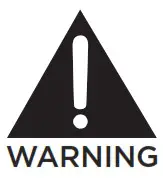 This indicates that hazards or unsafe practices may cause serious personal injury or death. To reduce the risk of fire, explosion, electric shock, or personal injury when using your washing machine, you SHOULD follow these basic safety precautions.
This indicates that hazards or unsafe practices may cause serious personal injury or death. To reduce the risk of fire, explosion, electric shock, or personal injury when using your washing machine, you SHOULD follow these basic safety precautions.
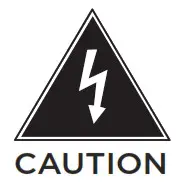 This indicates that hazards or unsafe practices may cause minor personal injury or property damage.
This indicates that hazards or unsafe practices may cause minor personal injury or property damage.
 This symbol indicates that there are important operating and maintenance instructions in the literature accompanying your washing machine
This symbol indicates that there are important operating and maintenance instructions in the literature accompanying your washing machine
 WARNING
WARNING
State of California Proposition 65 Warnings.
The California Safe Drinking Water and Toxic Enforcement Act requires the Governor of California to publish a list of substances known to the State of California to cause cancer, birth defects, or other reproductive harm and requires businesses to warn of potential exposure to such substances. This product contains a chemical known to the State of California to cause cancer, birth defects, or other reproductive harm. This appliance can cause low-Level exposure to some of the substances listed, including benzene, formaldehyde, and carbon monoxide.
Cancer and Reproductive Harm – www.P65Warnings.ca.gov.
 WARNING
WARNING
Do not store or use gasoline or other f1ammable vapors and liquids in the vicinity of this or any other appliance.
IMPORTANT SAFETY INSTRUCTIONS
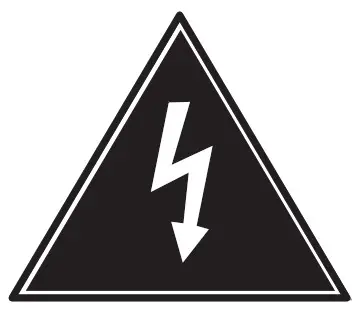 WARNING
WARNING
- Read all instructions before using the appliance.
- Use this appliance only for its intended purpose as described in this Owner’s Manual.
- Before use, the washer must be properly installed as described in this manual.
- ALWAYS follow the fabric care instructions supplied by the garment manufacturer.
- Do not wash articles that have been previously cleaned in, washed in, soaked in, or spotted with gasoline, dry-cleaning solvents, other flammable or explosive substances as they give off vapors that could ignite or explode.
- Do not allow children to play on or in the appliance. Close supervision of children is necessary when the appliance is used near children. Before the appliance is removed from service or discarded, remove the lid of the washing compartment.
- Do not reach into the appliance if the tub is moving.
- Do not install or store this appliance where it will be exposed to the weather or freezing temperatures.
- Do not tamper with the controls.
- Do not repair or replace any part of the appliance or attempt any servicing unless it is specifically recommended in the user maintenance instructions or in published user-repair instructions that you understand.
- Hydrogen gas is explosive. If the hot water system has not been used for two weeks or more, before using a washer, turn on all hot water faucets and let the water flow from each for several minutes. This will release any accumulated hydrogen gas. The gas is flammable, so do not smoke or use an open flame during this time.
- Keep the area underneath and around your appliance free of combustible materials (lint, paper, rags, and so on), gasoline chemicals, and other flammable vapors and liquids.
- Do not place items exposed to cooking oil in your washer. items contaminated with cooking oil may contribute to a chemical reaction that could cause a load to catch fire.
- This washer is not designed for maritime use or for mobile installations such as in RVs aircraft and other mobile platforms.
- Turn off the water faucets and unplug the washer if the machine is to be left for an extended period of time, such as during vacations.
- Packaging material can be dangerous for children. There is a risk of suffocation! Keep all packaging away from children.
- Always check the inside of the washer for foreign objects before loading laundry. Keep the lid closed when not in use.
 WARNING
WARNING
Installation Warnings and Precautions
- Plug the power cord into an AC 120V/60Hz wall socket rated at 15 amps or higher. Use the socket for this washer only. Do not use an extension cord.
– Sharing a wall socket with another appliance, using a power strip, or extending the power cord may result in electric shock or fire.
– Do not use an electric transformer. lt may result in electric shock or fire.
– Make sure that the power voltage, frequency and current match the product’s specifications. Failing to do so may result in electric shock or fire. - Remove all foreign substances such as dust or water from the power plug terminals and contact points using a dry cloth on a regular basis.
– Unplug the power plug and clean it with a dry cloth.
– Failing to do so may result in electric shock or fire. - Plug the power plug into the wall socket in the right direction so that the cord runs towards the floor.
– If you plug the power plug into the socket in the opposite direction, the electric wires within the cable may be damaged and this may result in electric shock or fire. - Plug the power plug into the wall socket firmly. Do not use a damaged power plug or loose wall socket, because this may result in an electric shock fire.
- Do not pull or excessively bend the power cord. Do not twist or tie the power cord.
- Do not hook the power cord over a metal object. Place a heavy object on the power cord, insect power cord between objects, or push the power cord into the space behind the appliance, because this may result in electric shock or fire.
- Do not pull the power cord when unplugging the power plug.
– Unplug the power plug by holding the plug.
– Failing to do so may result in electric shock or fire. - If the power plug or power cord is damaged, contact your nearest service center.
- Do not install on carpet. Install the washer on a level and solid floor that can support its weight. Failure to do so may result in abnormal vibration, noise, or problems with the product.
- The washer is heavy. Two or more people may be needed to install and move the appliance. Failure to do so may result in bodily or other injuries.
- Store and install the washer where it will not be exposed to temperatures below freezing or exposed to outdoor weather conditions. Failure to do so may result in serious leak damage.
- Position the appliance so that the power plug is easily accessible.
Failure to do so may result in electric shock or fire due to an electrical short circuit. - Failure to follow all of the safety warnings in this guide may result in property damage or injury to persons.
 WARNING
WARNING
Use and Maintenance warnings and Precautions
- If the appliance is flooded, cut the power immediately and contact your nearest service center.
- If the appliance emits a strange noise, a burning smell, or smoke, unplug the power plug immediately and contact your nearest service center. Failure to do so may result in electric shock or fire.
- In the event of a gas leak (such as propane or LP gas) ventilate the area immediately. Do not turn any appliance or light on or off.
– Do not use a ventilating fan.
– A spark may result in an explosion or fire. - Do not force the washer lid open while the washer is operating (high-temperature washing, drying, or spinning).
– Water flowing out of the washer may cause burns or cause the floor to be slippery. This may result in injury.
– Forcing the lid open can damage the product or cause injury. - Make sure to remove the packaging (sponge, styrofoam) attached to the bottom of the washer before using it.
- Do not insert your hand or a metal object under the washer. This may result in injury.
- Do not attempt to operate this appliance if it is damaged, malfunctioning, partially disassembled, or has missing or broken parts, including a damaged cord or plug. This may result in electric shock, fire, or death.
- Do not touch the power plug with wet hands. This may result in electric shock.
- Do not turn the appliance by unplugging the power plug while the washer is in operation. Plugging the power plug into the wall socket again may cause a spark and result in electric shock or fire.
- Keep all packaging material well out of the reach of children, as packaging materials can be dangerous to children. if a child places a bag over his or her head, he or she may suffocate.
- Do not let children or infirm persons use this washer unsupervised.
- Failure to do so may result in electric shock, burns, or injury.
- Do not attempt to repair, disassemble or modify the appliance yourself.
– Do not use any fuse (such as copper, steel wire, etc.) other than the standard fuse.
– If you need to pair or reinstall the appliance, contact your nearest service center.
– Failure to do so may result in electric shock, fire, problems with the product, or injury. - If any foreign substance such as water enters the appliance in any area other than the tub, unplug the power plug and contact your nearest service center. Failure to do so may result in electric shock or fire.
- If the water supply hose comes loose from the faucet and floods the appliance, unplug the power plug. Failure to do so may result in electric shock or fire.
- Do not mix chlorine bleach with ammonia or acids such as vinegar.
- Incorrect usage can produce poisonous gas, resulting in serious injury.
- Do not reach into the washer while parts are moving. Before loading, unloading, or adding items, press the Start Pause button and allow the tub to come to a complete stop before reaching inside. Failure to do so may result in electric shock injury or fire.
- Do not allow children to play on or in the washer. Close supervision of children is necessary when the washer is used near children. As children grow, teach them the proper, safe use of all appliances.
- Failure to do so may result in serious injury.
- Keep laundry products out of reach of children. Observe all warnings on product labels and follow them. Failure to do so may result in serious injury.
- Disconnect this appliance from the power supply before attempting any user maintenance. Pressing the Power button does not disconnect this appliance from the power supply. Failure to do so may result in electric shock, injury, or fire.
- Do not clean the appliance by spraying water directly onto it.
- Do not use benzene, thinner, or alcohol to clean the appliance. This may result in discoloration, deformation, damage, electric shock or fire.
- Unplug the power plug when the appliance is not being used for long periods of time or during a thunder/lightning storm. Failure to do so may result in electric shock or fire.
- Keep hands and foreign objects clear of the lid and latch area when closing the lid. Failure to do so may result in personal injury.
- If the washer is contaminated by a foreign substance such as detergent, dirt, or food waste, unplug the power plug and clean the washer with a damp, soft cloth. Failure to do so may result in discoloration, deformation. Damage or rust.
- The clear portion of the lid can be broken by a strong impact. Take care when using the washer. If the clear portion is cracked or broken, it may result in injury.
- After a water supply failure or when reconnecting the water supply hose, open the faucet slowly.
- Open the faucet slowly after a long period of non-use. The air pressure in the water supply hose or the water pipe may result in damage to a part or in water leakage.
- If a drain error occurs during an operation, check if there is a draining problem. If the washer is used when it is flooded because of a draining problem, it may result in electric shock or fire due to an electrical short circuit. Do not insert your hand or a metal object under the washer.
- This may result in injury.
- Insert the laundry into the washer completely so that the laundry does not get caught in the lid. LF laundry gets caught in the lid, it may result in damage to the laundry or the washer, or result in water leakage.
- Make sure that the faucet is turned off when the washer is not being used.
- Make sure that the water supply hose connectors are properly tightened. Failure to do so may result in property damage or injury.
- Open the faucet and check if the water supply hose connector is firmly tightened and that there is no water leaking before using the product.
- If the water supply hose connectors are loose, it may result in water leakage.
- Do not stand on top of the appliance or place objects (such as laundry, lighted candles, lighted cigarettes, dishes, chemicals, metal objects, etc.) on the appliance. This may result in electric shock, fire, problems with the product, or injury.
- Do not operate the appliance with wet hands. This may result in electric shock.
- Do not spray volatile material such as insecticide onto the surface of the appliance. As well as being harmful to humans, it may also result in electric shock, fire, or problems with the product.
- Do not place an object that generates an electromagnetic field near the washer. This may result in injury due to a malfunction.
- Since the water drained during a high-temperature wash or drying cycle is hot, do not touch the water. This may result in burns or injury.
- Do not wash, spin, or dry water-proof seats, mats, or clothing.
- Do not wash thick, hard mats even if the washer mark is on the care label. This may result in injury or damage to the washer, walls, floor, or clothing due to abnormal vibrations.
- Do not operate the washer when the detergent dispenser is removed.
This may result in electric shock or injury due to water leakage. - Do not insert your hand into the detergent dispenser after opening it.
This may result in injury because your hand may be caught. - Do not place any non-Laundry objects, such as shoes, food waste, or animals into the washer. This can cause abnormal vibrations that can damage the washer, and in the case of pets, cause severe injury or death.
- Do not press the buttons using sharp objects such as pins, knives, or fingernails. This may result in electric shock or injury.
- Do not wash laundry contaminated by oils, creams, or lotions usually found in skin-care shops or massage clinics. This may result in the rubber seal becoming deformed and water leakage.
- Make sure that the water inlet pipe is connected and the tap is opened before washing clothes.
- Do not leave metal objects (safety pins, hairpins, and so on) or bleach in the tub for long periods of time. This may cause the tub to rust.
– If rust appears on the surface of the tub, apply a neutral cleansing
agent to the surface and use a sponge to clean it. Never use a metal brush. - Do not use hot water from water cooling/heating devices. This may result in problems with the washer.
- Do not use natural hand-washing soap in the washer. if it hardens and accumulates inside the washer, it may cause problems with the product, discoloration, rust, or bad odors.
- If using a washing net with this machine (not provided), do not wash laundry items such as bedding in the washing net. Doing so may result in injury due to abnormal vibrations. Place only smaller items such as lace socks and lingerie in the washing net.
- Do not use hardened powdered detergent. If it accumulates inside the washer, it may result in water leakage.
- Do not wash throw rugs or doormats. Doing so may cause sand to accumulate inside the washer, resulting in mechanical problems.
 WARNING
WARNING
Grounding/Earthing
- This appliance must be properly grounded.
- Do not ground the appliance to a gas pipe plastic water pipe or telephone line.
– Improper grounding may result in electric shock, fire, explosion, or problems with the product.
– Never plug the power cord into a socket that is not grounded correctly. Make sure that the socket you use is grounded in accordance with local and national codes.
 WARNING
WARNING
Choosing a Proper Location
- Do not install this appliance near a heater or inflammable material.
- Do not install this appliance in a humid, oily, or dusty location, or in a location exposed to direct sunlight or water (raindrops).
- Do not install this appliance in a location where gas may leak. Failure to do so may result in electric shock or fire.
- If the washer is moved to a new location, have it checked and reinstalled by a qualified service technician. Failure to follow this warning may result in electric shock or fire.
- Do not pull the power cord or drain outlet hose to move the appliance to desired location place.
FEATURES
Package Contents
Make sure that the following items came with your washer
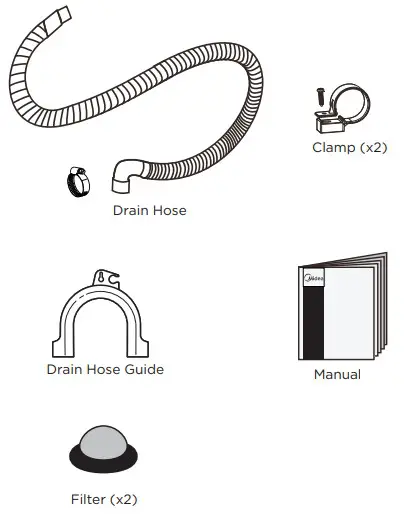
NOTE:
- Use the clamps to secure the drain hose to the washer rear panel.
- Use the filters to replace the rubber washers in the water hoses (faucet sides).
Main Components
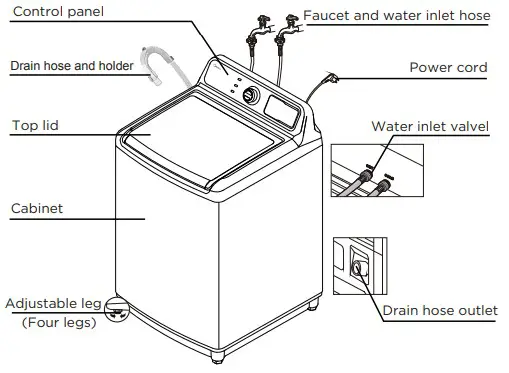
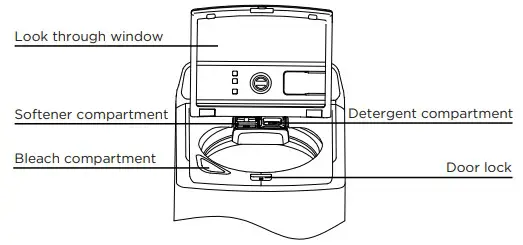
INSTALLATION REQUIREMENTS
Electrical requirements
 WARNING
WARNING
To reduce the risk of ire, electric shock, or injury to persons, read the SAFETY INSTRUCTIONS before operating this appliance.
Use a 120 Volt, 60Hz, 15 amp fuse or circuit breaker. We recommend an individual branch circuit that serves only your washer.
 WARNING
WARNING
Never use an extension cord.
Electrical grounding is required for your washer.
You must ground your washer. IN the event of a malfunction or breakdown, grounding reduces the risk of electric shock by providing a path of least resistance for the electric current.
Your washer is equipped with a power cord with a three-pronged grounding plug for use in a correctly installed and grounded outlet.
The outlet must be correctly installed and grounded in accordance with all local codes and ordinances.
 WARNING
WARNING
- You are responsible for providing adequate electrical services for your washer.
- An incorrectly connected equipment-grounding conductor can increase the risk of electrical shock. Check with a qualified electrician or serviceman if you are not sure whether your washer is grounded correctly.
- Do not modify the power cord plug that came with your washer. if the plug does not fit the outlet, have the correct type of outlet installed by a qualified electrician.
- To prevent unnecessary risk of fire, electrical shock or personal injury, all wiring and grounding must be done in accordance with the
National Electrical Code ANSI/FNPA, No.70 Latest Revision, and local codes and ordinances. - Never connect the ground wire to plastic plumbing lines, gas lines, or hot water pipes.
Water requirements
To fill your washer in the correct amount of time, the water pressure needs to be between 14 and 116 psi (100 to 800 kPa).
- If the water pressure is less than 14 psi (100 kPa):
- The water valve may fail or may not shut off completely.
- The time it takes to fill your washer may be longer than the time your washer controls allow. Your washer will turn off and report an error. A time limit is built into the controls to prevent flooding in your home if a hose becomes loose.
- Water inlet hoses must be purchased separately. You can buy inlet hoses in various lengths up to 8 ft. (240 cm).
To avoid the possibility of water damage: - Make sure that the water faucets are easily accessible.
- Turn off the faucets when you are not using your washer.
- Periodically check to make sure that water is not leaking from the water hose fittings.
Drainage requirements
- The recommended height for the drain standpipe is 48 in. (122 cm).
- The drain hose must be routed through the drain hose clip to the standpipe.
- The standpipe must be large enough to accept the outside diameter of the drain hose.
INSTALLATION INSTRUCTIONS
Unpacking your washer
 WARNING
WARNING
- Packing materials can be dangerous to children. Keep all packing materials (plastic bags, polystyrene, and so on) well out of the reach of children.
- Do not operate your washer on the foam base cushion. Doing so will result in serious vibration, which could cause equipment damage or result in physical injury.
Remove the packing box and lift the washer up and away from the foam base cushion. Open the lid of the washer to take out all accessories including the protective foam.

Choosing a location
 WARNING
WARNING
- Do not install your washer in areas where water may freeze, because your washer always retains some water in its water valve, pump, and hose areas. Frozen water can damage the valve, pump, hoses, and other components.
- Never install on a platform or weakly supported structure.
For best performance, you must install your washer on a solid, level floor. Wooden floors may need to be reinforced to minimize vibration or unbalanced load situations.
Carpeting and soft tile surfaces can contribute to excessive vibration, which can cause your washer to move slightly during the spin cycle.
Washer dimensions and installation measurements

If you install your washer in an alcove or closet, the front of the closet must have two unobstructed air openings for a combined minimum total area of 72 sq. in. (465 sq.cm) with a minimum clearance of 3 in. (7.6 mm) at the top and bottom. A slatted door with equivalent space clearance is acceptable.
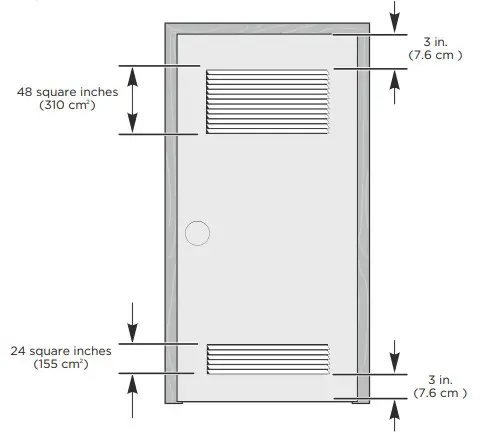
Installing in an alcove or closet
Minimum clearances between your washer and adjacent walls or other surfaces are:
- Either side: 1 in. (2.5 cm)
- Rear: 6 in. (15.2 cm)
- Closet Front: 2 in. (5.1 cm)
- Top: 24 in. (61 cm)
- The gap between the end of the water valve and the wall:
– Case 1: If you connect the supply hose after you install your washer: Over 3.9 in. (10 cm)
– Case 2: If you connect the supply hose before you install your
washer: Over 2.8 in. (7 cm)
If you install your washer and dryer side-by-side in a closet, the closet front must have an unobstructed air opening of at least 72 square inches (465 square cm).
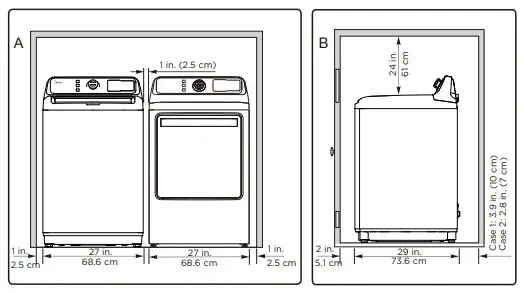
A. Recessed area
B. Side view – closet or confined area
 WARNING
WARNING
Before you install your washer, make sure that the location:
- Is a hard, level surface without carpeting or soft flooring that can obstruct ventilation?
- Is away from direct sunlight.
- Has adequate ventilation.
- Is not exposed to freezing temperatures (32 F or 0 C).
- Is away from heat sources such as oil or gas.
- Has enough space so that the washer does not rest on its power cord.
Tools you will need

Connect the water hoses
NOTE: The water supply hoses are not supplied with your washer and must be purchased separately.
 Caution
Caution
- Use new water supply hoses. Using old hoses can result in leakage or overflow that can damage your property.
- Do not connect multiple water supply hoses together to increase the length of the hose. Hoses connected this way can leak and cause
electrical shock. If a hose is too short, replace the hose with a longer, high-pressure hose.
- Make sure that there are rubber washers inside the fittings at both ends of each new water hose. Remove the rubber washers on the faucet side and replace them with filters. Installing the water supply hoses without rubber washers can cause water leakage.

- Tighten the hose and faucet fittings by hand until they are snug, then tighten them an additional two-thirds of a turn with pliers or a wrench.
Pull the water supply hoses downwards to make sure that they are connected securely.
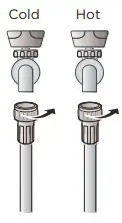
 Caution
Caution
Do not overtighten the fittings or apply tape or sealant to the faucets or water supply intake. This can damage the fittings. - Place the unconnected ends of the hoses into a bucket and turn on the faucets connected to the water supply hoses for 10 or 15 seconds to remove any foreign substances. Turn off the faucets.
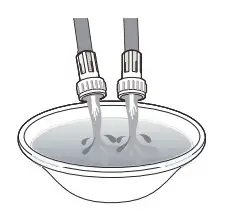
- Connect the ends of the water supply hoses to the water supply intake connections at the top of the washer. Make sure that the rubber washers are in place. The water supply hose connected to the hot faucet must be connected to the hot water supply intake and the water hose connected to the cold faucet must be connected to the cold water supply intake.
 NOTE: If you do not want to use the hot water supply hose, insert a water intake cap into the hot water supply intake hole. In this case, you must select the Tap Cold option for the water temperature.
NOTE: If you do not want to use the hot water supply hose, insert a water intake cap into the hot water supply intake hole. In this case, you must select the Tap Cold option for the water temperature.
NOTE: No intake cap is provided with your washer. It must be purchased separately. - Tighten the fittings by hand until they are snug, and then tighten them an additional two-thirds of a turn with a wrench.
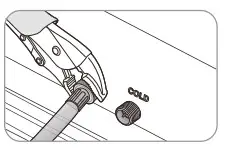
 Caution
Caution
Do not overtighten the fittings or apply tape or sealant to the faucets or water supply intakes. This can damage the fittings.
Make sure that the water supply hoses are not twisted or bent. A bent or twisted hose can leak and cause an electric shock due to the water leakage. To ensure the correct water usage, connect both hot and cold water faucets. if either or both are not connected, an error code could occur. - Turn on the hot and cold water supplies and check all the water supply intake connections and the faucets for water leaks.
Connect the drain hose
 Caution
Caution
- Failure to slide the drain hose completely over the washer’s drainpipe may result in water leakage.
- Failure to move the clamp or hoop onto the washer’s drainpipe will result in water leakage.
- Find the end of the drain hose that has the clamp, then slide the clamp away from the end of the hose.
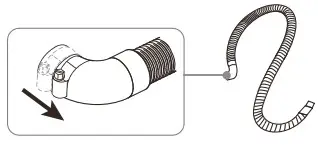
- Insert the drain hose with the clamp onto the washer’s drainpipe.
Make sure that the drain hose completely covers the end of the drain pipe.
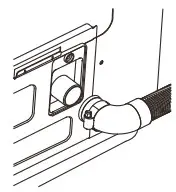
- Move the clamp toward the drainpipe outlet. Tighten the clamp with a flat blade screwdriver.
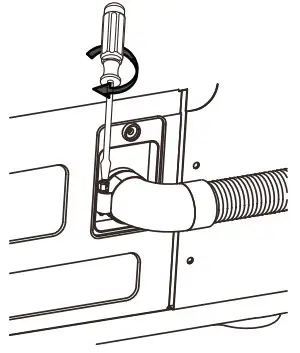
- Fasten the drain hose to the washer frame at the indicated directions with the hose clamps (2) provided, using a Phillips screwdriver.
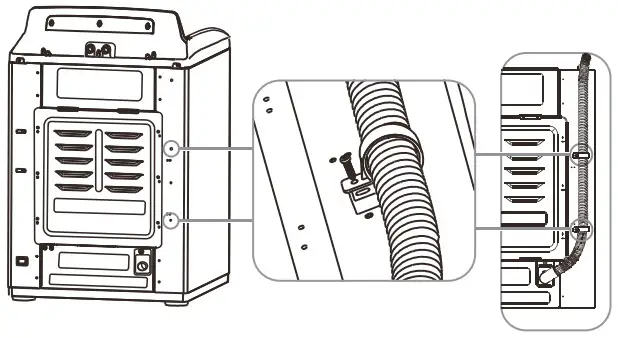
- Position the other end of the drain hose (the loose end) in one of the following ways:
 Caution
Caution
Make sure that the connection between the drain hose and the washbasin, standpipe, or laundry tub is not airtight.
- Over the edge of washbasin – Secure the guide to the side of the basin wall with a hook, tape it or tie it with a piece of cord to prevent the drain hose from moving.
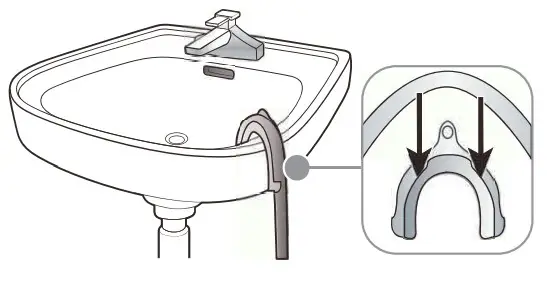
- In a standpipe – The standpipe must be no shorter than39 in. (99 cm) and no longer than 96 in. (244 cm).
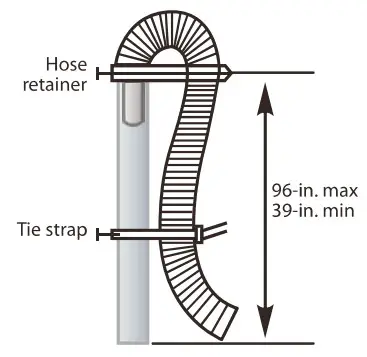
- In a laundry tub – The laundry tub must be no shorter than 39-in. (99 cm) and no higher than 96-in (244 cm) maximum.
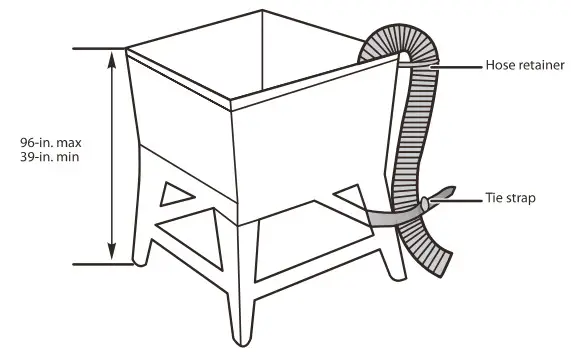
Level your washer
 Caution
Caution
Do not use your washing machine without leveling. If your washer is not level, it may:
- Vibrate excessively which can cause your washer to malfunction.
- Make excessive noise.
- Indicate error codes E3, E4, or E5 when the washer is running.
Extend the leveling feet only as much as is necessary. If the feet are extended too much, your washer may vibrate.
Determine if the washer is level by checking the position of the tub or by using a level.
- Slide the washer into position.
- Open the lid of the washer, then pour water into the tub to the leveling circle. If the washer is level, the water will touch the leveling circle all the way around. If the washer is not level, the water will only touch a part of the leveling circle.
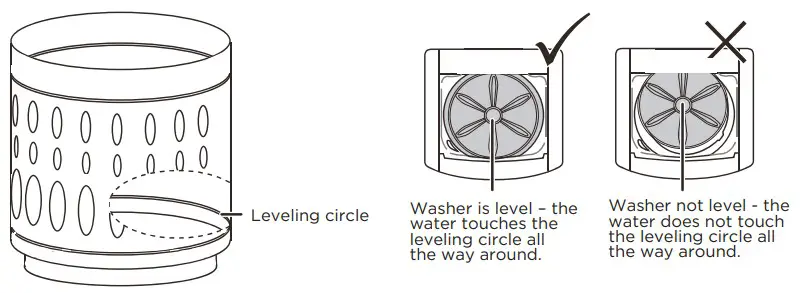
- If your washer is not level, carefully tilt your washer just enough to adjust the leveling feet on the bottom front of your washer. Extend the feet only as much as is necessary. If the feet are extended too much, your washer may vibrate.

Power on
Plug the power cord into a well-grounded, 3-prong, 120 Volt 60 Hz approved electrical outlet, protected by a 15-amp fuse or comparable circuit breaker. Your washer is grounded through the third prong of the power cord.
Run a test cycle
Run a test cycle to make sure that your washer is properly installed.
- Load about 6 pounds (2.7 kg) of laundry into the tub.
- Press the Power button to turn on your washer.
- Turn the cycle selector to select the Rinse & Spin cycle.
- Press the Start Pause button to start the test cycle. Your washer should not rock or vibrate excessively when water fills the tub or when washing or spinning. The washer should drain well during the spin cycle.
 Caution
Caution
- If you detect any water leaks while the washer is filling or draining, check the water connections. See Connect the water hoses on page 19 or Connect the drain hose on page 21.
- If the washer rocks and/or vibrates excessively, level it again. See Level your washer on page 24.
WASHER USE
Control panel
MLV45N1BWW
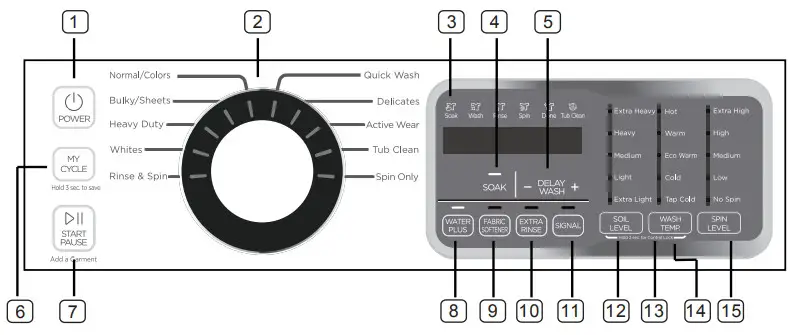
MLV45N3BWW

- POWER
Press to turn on your washer. Press again to turn off your washer. If you leave your washer on and do not press the START PAUSE button within 10 minutes, your washer will automatically turn off. - Cycle selector
Turn to select a wash cycle. The cycle you select determines the wash pattern for the cycle. For more information, see Washer options and settings on page 35. - Digital display
The initial display is the total time for the cycle you select.
While your washer is running, the display shows the cycle process and time remaining in the cycle.
NOTE: the time shown is an estimate based on normal operating conditions.
External factors (such as the load size, room temperature, incoming water temperature, and water pressure) can affect actual time. If you set a delay time for the start of the cycle, the display shows the time when the cycle will start. - SOAK
Press to select the SOAK option. Press again to cancel. Select this option for heavily soiled items that need to soak to remove stains and heavy dirt.
Soak occurs after the tub fills and detergent is added but before the wash process. The agitator or impeller will rotate seral times during the soak process. - Delay
Press to select a time when you want the cycle to begin. You can set the time up to 24 hours in advance in one-hour increments. The display shows the time when the cycle will start. For more information, see Set a delayed start time on page 32. - MY CYCLE
Press and hold for 3 seconds to remember your favorite washing cycle.
Press once to load your favorite cycle settings. - START PAUSE
Press once to start the wash cycle. Press again to pause the cycle. If you pause the cycle, you can add or remove items, but you cannot change any settings. Press again to restart the cycle. - WATER PLUS
Press once to increase one higher water level. Press again to cancel this function. If the water level is already set to the highest, the level will not change. - FABRIC SOFTENER
Add liquid fabric softener to the fabric softener compartment, and then press this button. The fabric softener will be added to the cycle at the correct time. - EXTRA RINSE
Press to add an extra rinse to the wash cycle. Press again to cancel. - SIGNAL
The sound-off function can be selected during all courses. - SOIL LEVEL
Press to select the soil level. Different soil levels result in different washing times and wash cycle settings. For more information, see Washer options and settings on page 35. - Control lock
Press and hold the SOIL LEVEL and Temp. buttons at the same time for 3 seconds to turn on the child lock function. Press and hold these buttons again for 3 seconds to turn off the function. When the child lock function is turned on, the only button that works is the POWER button and the SOIL LEVEL and Temp. buttons you use to turn off the child lock. - WASH TEMP.
Press to select the washing water temperature. The rinse water temperature is always cold. - SPIN LEVEL
Press to select the spin level to increase the spin time or short the spin time. This function can be selected with Normal/Colors and Tub Clean cycle.
Washing a load of laundry
 WARNING
WARNING
To reduce the risk of fire, electric shock, or injury to persons, read the SAFETY INSTRUCTIONS before operating this appliance.
Selecting a detergent
Your washer is designed to use high efficiency (HE) detergents.
- For the best cleaning results, use an HE detergent. We recommend that you do not use a regular detergent. HE detergents contain suppressors that reduce or eliminate suds. When fewer suds are produced, the load tumbles more efficiency, and cleaning is maximized.
- Reducing the amount of detergent may reduce the quality of cleaning.
Make sure that you:
– Pre-treat stains.
– Sort carefully by color and soil level.
– Avoid overloading.
Turn on your washer
Press the Power button to turn on your washer. Your washer’s initial settings are
- Normal on cycle selector with — displayed on the digital display.
- Medium for the Soil Level.
- Warm for the Wash Temp.
Load your washer
 Caution
Caution
Before loading your laundry, make sure that you remove coins, keys, and other hard objects and close zippers. These items may damage clothes.
- Sort laundry by fabric type, soil level, color, and load size.
- Fill the tub with dry, unfolded clothes. Load the tub no more than 3/4 fill.
NOTE:
- Overloading may reduce washing efficiency, cause excess wear, and possibly cause creasing or wrinkling of the load.
- Wash delicate items such as bras, hosiery, and other lingerie on the Delicates cycle with similar lightweight items.
- When washing big, bulky items (such as rugs or pillows) or a few smaller items (such as stuffed toys or one or two sweaters) that do not fill the tub completely, add a few towels to improve spin performance.
- Always use the Bulky cycle for bulky items.
- When washing heavily soiled loads, do not overload your washer to ensure good cleaning results.
Load your washer
 Loading the liquid or powder detergent compartment
Loading the liquid or powder detergent compartment
- Pour the recommended amount of laundry detergent directly into the compartment before starting your washer.
- If you are using color-safe bleach, add it with the detergent to the detergent compartment.
NOTE:
- When adding color-safe bleach with detergent, both laundry products should be in the same form (liquid).
- If no detergent compartment, you should add the detergent into the tub.
Loading the bleach compartment (liquid bleach only)
- Add chlorine bleach to the bleach compartment. Do not over-fill the compartment.
- there is no water inlet to the bleach dispenser, so the bleach will directly load into the tub when you pour it in.
 Caution
Caution
- Avoid splashing or over-filling the compartment.
- Never pour undiluted liquid chlorine bleach directly onto the load or into the tub. Doing so can damage fabrics, by weakening the fibers or stripping the color.
NOTE: Do not pour color-safe bleach into the bleach compartment. Instead, add it to the detergent compartment.
Loading the fabric softener compartment
- Pour the recommended amount of liquid fabric softener into the softener compartment. The dispenser automatically releases the liquid fabric softener at the correct time during the rinse cycle.
 Caution
Caution
- Use the softener compartment ONLY for liquid fabric softeners.
- Do not use the Downy Ball in the fabric softener compartment.
- Do not use a liquid fabric softener that is too sticky as it may not mix with the water sufficiently.
- Be sure to select the Fabric Softener option when using fabric softener so that it is released in the rinse portion of the cycle.
Select the appropriate cycle and options for the load
- Turn the cycle selector to select a washing cycle. For information on wash cycles, see Washer options and settings on page 35.

- Optional: Use the control panel buttons (like Fabric Softener) to customize the washing cycle. For descriptions of buttons, see the Control panel on page 27. For information about which buttons are available for each cycle type, see Washer options and settings on page 35.
(Optional) Set a delayed start time
You can program a wash cycle, then set a time when you want a wash cycle to begin.
- Press the DELAY WASH button to turn on the delay start time function.
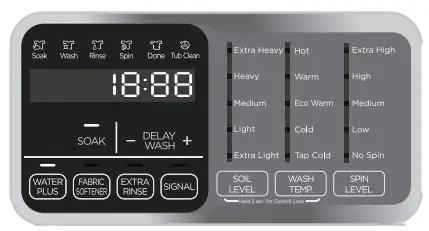
- Press the Delay button repeatedly to select the delay time you want.
The delay start time, in hours, will be shown on the display, in sequence, from 0 to 24, then back to 0. You can also press and hold the Delay button to quickly adjust the time until the desired time appears on the display. - If you want to change the wash cycle settings while you are setting the delay start time, turn the cycle selector. To return to set the delay start time function, repeat Steps 1 and 2.
NOTE:
- Once the number of delay hours is reached by pushing the Delay button, release the button for three seconds and it will be set. The delayed light will remain on.
- After the delay time is set, if you wish to change the delay setting, press the Delay button again until the desired hour is reached.
Release the button for three seconds and it will be set. - If you decide to cancel the delay setting, you can either turn the cycle selector or push the Delay button until 0 is reached.
- Ideally, you should set your cycle before setting the Delay, because turning the cycle selector after the delay is set cancels the delay.
- The Delay Start Time cannot be changed after the program has started.
- To cancel the delay start time function before you save the setting, press the Delay button until 0 appears on the display, or turn the cycle selector knob.
IMPORTANT:
- You can change settings or cancel the delay start time function anytime before you press the Start Pause button by turning the cycle selector. The delay start time cannot be changed after you press the Start Pause button.
- If you pressed the Start Pause button, you can cancel the delay start-time function by pressing the Power button to turn off your washer, then pressing the Power button again to turn it back on.
Start your washer
- Press the Start Pause button.
NOTE
- If you have not set a delayed start time or if the delay time has expired, your washer starts the cycle and the Wash light turns on.
- As your washer moves from stage to stage in the wash cycle, the related light turns on (such as Rinse or Spin).
- If you set a delayed start time, the Delay light turns on, and your washer starts counting down the start time.

- If you need to pause the cycle (for example to add or remove items or adjust the load), press the Start Pause button, then open the lid. Your washer stops. When you are ready to resume washing, close the door, then press the Start Pause button.
Unload your laundry
When the wash cycle is complete:
- The done light turns on.
- Your washer beeps six times and flashes 11, 22, 33, 44, 55, 66 after the cycle is done.
- Your washer unlocks the lid.

- Open the lid and remove the laundry.
Setting the child lock
Your washer has a child lock function to prevent children from playing with your washer. When you turn on the child lock, the only buttons that work are the Power button and the Soil Level and Temp. buttons you use to turn off the child lock.
- Press and hold both the Soil Level and Temp. buttons for three seconds.
The child lock light turns on.

- To turn off the child lock, press and hold both the Soil Level and Temp.
buttons for three seconds.
NOTE: - If your washer is not turned on, the child lock can still remain set.
Press the Power button, turn on the child lock function, then press the Power button to turn off your washer. When you want to use your washer, you need to turn off the lock function. - If you turn on the child lock function while the washer lid is open, E3 appears on the display. If you do not close the lid within 20 seconds, your washer sounds an alarm, displays CL, and drains all the water in the tub. To clear the alarm, press the Power button to turn off your washer.
Washer options and settings
Options and settings table of MLV45N1BWW.
- Maximum load weight= 18.65 lbs (8.46 kg) (Dry clothes)
- Bolded options are initial settings. (dots) indicate options functions you can select.
| Cycle | Fabric type | Soil level options | Temp. options | Spin Level options | Delay | Soak | Extra rinse | Fabric softener | Water Plus | Signal |
| Normal/ Colors | Cotton, linen Towels, Shirts Sheets, Jeans Mixed loads | Extra Heavy Heavy Medium Light Extra Light | Hot Warm Eco Warm Cold Tap Cold | • | • | • | • | • | • | |
| Heavy Duty | Heavily soiled
cotton fabrics |
Extra Heavy Heavy Medium Light Extra Light | Hot Warm Eco Warm Cold Tap Cold | Extra-High High Medium Low No spin | • | • | • | • | • | • |
| Tub Clean | See page 36 | Extra Heavy | Hot | • | • | |||||
| Spin Only | Extra-High High Medium Low No spin | • | • | |||||||
| Rinse & Spin | Warm Eco Warm Cold Tap Cold | Extra-High High Medium Low No spin | • | • | • | • | ||||
| Bulky/ Sheets | Large items like blankets and comforters | Extra Heavy Heavy Medium Light Extra Light | Hot Warm Eco Warm Cold Tap Cold | Extra-High High Medium Low No spin | • | • | • | • | • | • |
| Delicates | Dress shirts Blouses Nylons Sheer/lacy | Heavy Medium Light Extra Light | Hot Warm Eco Warm Cold Tap Cold | Extra-High High Medium Low No spin | • | • | • | • | • | • |
| Quick Wash | Lightly soiled and small loads | Medium Light Extra Light | Hot Warm Eco Warm Cold Tap Cold | • | • | • | • | • | • | |
| Whites | White Fabric | Medium Light Extra Light | Hot Warm Eco Warm Cold Tap Cold | Extra- high High Medium Low No spin | • | • | • | • | • | • |
| Activewear | Active Wear | Heavy Medium Light Extra Light | Hot Warm Eco Warm Cold Tap Cold | Extra High High Medium Low No spinDelay | • | • | • | • | • | • |
WASHER CARE
 Caution
Caution
Turn off the water faucets after final use. This shuts off the water supply to your washer and prevents the possibility of damage from escaping water. Leave the lid open to let the inside of your washer dry out.
CLEANING AND MAINTENANCE
Cleaning the exterior
Use a soft cloth to wipe up all detergent, bleach, or other spills as they occur.
Cleaning the interior
- Clean the interior of your washer periodically to remove any dirt, soil, odor, mold, mildew, or bacterial residue that may remain in your washer as a result of washing clothes.
- Failure to follow these instructions may result in unpleasant conditions, including odors or permanent stains in your washer or on your laundry.
- To remove hard water deposits, use a cleaner labeled “Washer safe”.
Cleaning the control panel
- Clean with a soft, damp cloth. Do not use abrasive powders or cleaning pads.
- Do not spray cleaners directly on the panel. The control panel finish may be damaged by some laundry pre-treatment soil and stain remover products. Apply such products away from your washer and wipe up any spills or overspray immediately.
Cleaning the detergent, bleach, or softener compartment
- To remove laundry product residue, wipe with a damp cloth and towel dry.
- You can remove the bleach detergent and softener compartments to clean them.
Cleaning the tub The Tub
The clean cycle is a self-cleaning cycle that removes the causes of odors that may occur inside your washer without using a cleaning agent. We suggest cleaning the tub about once a month.
Caution
Never use the tub clean cycle when laundry is in your washer. This may damage the laundry or your washer.
- With the tub empty, add one cup of chlorine bleach to the bleach dispenser.
- Press the Power button.
- Turn the cycle selector to Tub Clean. When you select Tub Clean, the only option you can change is the delay option.
- Press the Start Pause button.
Storing your washer
You can damage your washer if you do not remove water from hoses and internal components before storage.
To prepare your washer for storage:
- Select the Quick Wash cycle and add bleach to the washer. Run your washer through the cycle without a load.
- Turn the water faucets off and disconnect the inlet hoses.
- Unplug your washer from the electrical outlet and leave your washer lid open to let air circulate inside the tub.
 Caution
Caution
If your washer has been stored in below-freezing temperatures, allow time for any leftover water in your washer to thaw out before use.
BEFORE YOU CALL FOR SERVICE…
Troubleshooting Tips
Save time and money! Review the charts on the following pages first and you may not need to call for service.
| Problem | Solutions |
| The washer does not start |
|
| No water or not enough water |
|
| When washer has excessive vibration or noise |
|
| Washer stops |
|
| The lid is locked or will not open |
|
| The washer does not drain or spin |
|
| The water temperature is not correct |
|
| Load is too wet at the end of the cycle |
|
| Water leaks |
|
| Overseas condition |
|
| Prevent odor |
|
ERROR CODES
| Description | Reason | Solutions |
| E1 | The unit takes more than 10 minutes to drain. |
|
| E2 | The lid is open. The washer is not level. |
|
| E3 | Your washer is out of balance more than three times in spin operation. |
|
| E4 | Your washer is not level. Impact switch failed. |
|
| E5 | The EEPROM failed |
|
| F2 | Load sensing failed. |
|
| F5 | The water level sensor failed. |
|
| F8 | The lid lock failed. |
|
| Fd | The PCB failed. |
|
| C9 | The lid has been open for over 20 seconds with the Child Lock function activated. |
|
| MIDEA LAUNDRY WASHER LIMITED WARRANTY | ATTACH YOUR RECEIPT HERE. PROOF OF PURCHASE IS REQUIRED TO OBTAIN WARRANTY SERVICE.
Please have the following information available when you call the Customer Service Center: ■ Name, address, and telephone number |
| IF YOU NEED SERVICE:
1. Before contacting us to arrange service, please determine whether your product requires repair. Some questions can be addressed without service. Please take a few minutes to review the Troubleshooting section of the User Manual, or email [email protected] 2. All warranty service is provided exclusively by our authorized Midea Service Providers, in the U.S. and Canada. Midea Customer Service In the U.S.A. or Canada, call 1-866-646-4332 or email [email protected]. |
| LIMITED WARRANTY |
| WHAT IS COVERED |
| FIRST-YEAR LIMITED WARRANTY (PARTS AND LABOR)
For one year from the date of purchase, if this major appliance is installed, operated and maintained according to instructions attached to or furnished with the product, Midea America Corporation (hereafter “Midea”) will pay for factory specified replacement parts and repair labor to correct defects in materials or workmanship that existed when this major appliance was purchased, or at its sole discretion replace the product. In the event of product replacement, your appliance will be warranted for the remaining term of the original unit’s warranty period. LIFETIME LIMITED WARRANTY (STAINLESS STEEL TUB) For the lifetime of the product from the date of original purchase, when this major appliance is installed, operated, and maintained according to instructions attached to or furnished with the product, Midea will pay for factory specified parts and repair labor for the following components to correct non-cosmetic defects in materials or workmanship that existed when this major the appliance was purchased: ■ Stainless steel tub YOUR SOLE AND EXCLUSIVE REMEDY UNDER THIS LIMITED WARRANTY SHALL BE PRODUCT REPAIR OR REPLACEMENT AS PROVIDED HEREIN. Service must be provided by a Midea designated service company. This limited warranty is valid only in the 50 States of the United States or Canada and applies only when the major appliance is used in the country in which it was purchased. This limited warranty is effective from the date of the original consumer purchase. |
LIMITED WARRANTY |
| WHAT IS NOT COVERED |
The cost of repair or replacement under these excluded circumstances shall be borne by the customer. DISCLAIMER OF IMPLIED WARRANTIES IMPLIED WARRANTIES, INCLUDING ANY IMPLIED WARRANTY OF MERCHANTABILITY OR IMPLIED WARRANTY OF FITNESS FOR A PARTICULAR PURPOSE, ARE LIMITED TO ONE YEAR OR THE SHORTEST PERIOD ALLOWED BY LAW. Some states and provinces do not allow limitations on the duration of implied warranties of merchantability or fitness, so this limitation may not apply to you. This warranty gives you specific legal rights, and you also may have other rights that vary from state to state or province to province. DISCLAIMER OF REPRESENTATIONS OUTSIDE OF WARRANTY Midea makes no representations about the quality, durability, or need for service or repair of this major appliance other than the representations contained in this warranty. If you want a longer or more comprehensive warranty than the limited warranty that comes with this major appliance, you should ask Midea or your retailer about buying an extended warranty. LIMITATION OF REMEDIES; EXCLUSION OF INCIDENTAL AND CONSEQUENTIAL DAMAGES YOUR SOLE AND EXCLUSIVE REMEDY UNDER THIS LIMITED WARRANTY SHALL BE PRODUCT REPAIR AS PROVIDED HEREIN. MIDEA SHALL NOT BE LIABLE FOR INCIDENTAL OR CONSEQUENTIAL DAMAGES. Some states and provinces do not allow the exclusion or limitation of incidental or consequential damages, so these limitations and exclusions may not apply to you. This warranty gives you specific legal rights, and you also may have other rights that vary from state to state or province to province. |

REGISTRATION INFORMATION
PROTECT YOUR PRODUCT:
We will keep the model number and date of purchase of your new Midea product on file to help you refer to this information in the event of an insurance claim such
as fire or theft.
Register online at https://us.midea.com/product-registration
OR
Please fill out and return it to the following address:
Midea America Corp. 759 Bloomfield Ave #386, West Caldwell, NJ 07006-6701
———————————– (detach here) —————————-
| Name: | Model#: Serial #: Card: |
| Address: | Date Purchased: Store / Dealer Name: |
| City: State: Zip: |
E-mail Address: |
| Area Code: Phone Number: |
Occupation: |
| Did you purchase an additional warranty: | As your Primary Residence: |
| How did you learn about this product:
❑ Advertising |
Age: Marital Status: |
Information collected or submitted to us is only available to company internal employees for purposes of contacting you or sending you emails, based on your request for information and to company service providers for purposes of providing services relating to our communications with you. All data will not be shared with other organizations for commercial purposes.
Please consider leaving a customer review at www.midea.com.
Midea America Corp.
5 Sylvan Way,
Parsippany, NJ 07054
Customer Service 866-646-4332
Made in China


